國立臺灣師範大學設計研究所博士生 指導教授 - 林磐聳
PhD student of Department of Design, NTNU Advisor - Apex Lin
Article of famous designers
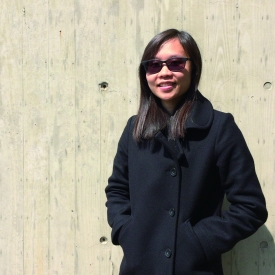
國立臺灣師範大學設計研究所博士生 指導教授 - 林磐聳
PhD student of Department of Design, NTNU Advisor - Apex Lin
I. Preface
The 21st century is the era of creative economy for the entire world. As the cultural and creative sectors prosper, it is necessary for design education to take root and become creativity-oriented. Talent is the core of creative capital (Lin Yan-dan, 2011). Faced with such a cultural and creative trend, advanced countries have viewed cultural and creative talent as an index for measuring the competitiveness of a nation. That is to say, talent is an essential foundation for national development, and it is necessary to cultivate talent early on in order to fulfill the needs of the future when things will become ever-changing. Therefore, I believe that establishing a strategic model for the cultivation of design talent for the cultural and creative industry in Taiwan will be beneficial in enhancing national strengths, making Taiwan a pioneer in design development for the entire Chinese-speaking world and an important hub of creative and design knowledge and capabilities.
Upon the juncture of social development and industry upgrade, “the cultural and creative industry” is the core driver for the six major emerging industries proposed by the Taiwan government. It cultivates design and creative human resources, which will become competitive strengths of the future. “The Project of Art and Design Talent Cultivation” under the Ministry of Education plays a fundamental role in terms of talent cultivation (Apex Lin, Pang-Soong, 2014). Professor Apex Lin, Pang-Soong is the manager of “International Design Competition” and “Taiwan International Student Design Competition” under this Project, and he has set up a role model and specified his core beliefs on design education by saying, “It takes ten years to cultivate a tree and one hundred years to cultivate talent.” “Talent is fundamental; the ‘people’ element is fundamental.” In other words, only the education of people is the solution in the long term. Talent cultivation is a task of enormous importance and cannot be achieved overnight; it is essential to build up mechanisms step-by-step before such mechanisms can grow and prosper.
When it comes to studying the cultural and creative industry, Taiwan, mainland China, Hong Kong and Macau have mostly focused on the industry perspective and rarely tackled the aspect of human resources. However, land and other natural resources, labor and material capital nowadays are no longer determining competitive advantages or factors of production for a country. Instead, the capital of knowledge, innovation and creativity from human resources can generate more added value and opportunities for sustainable development (United Nations’ Conference on Trade and Development as the original author, and Lin, yan-dan as the chief editor, 2011). In addition, Taiwan as well as countries around the world all view “design” as a key factor in future economic transformation, social development and the enhancement of quality of life (Apex Lin, Pang-Soong, 2009). In view of this, the cultivation of design talent with cultural and creative thinking and the reservation of such talent for the future needs in the design sector are the goals aimed at by design education of today, and they are also the research topic that I am interested in exploring.
As information technology keeps advancing and brings about changes in lifestyles, what are the key competences expected from design talent against such a global trend? In the era of interdisciplinary collaboration, how can Taiwan’s design education policy go across national borders and build a bridge to allow for exchanges with international design education? How can design education transform itself so that talent cultivation can balance the supply and demand of human resources in the industry and academia and fulfill the goal of sustainable development? Through literature review, I aim to understand the development of art and design talent cultivation in Taiwan, construct design strategies and methods, and allow design education to take root to cultivate cultural and creative talent so that design education in Taiwan can take the lead internationally.
I aim to take the human capital theories to examine the cultural and creative industry policy strongly promoted by Taiwan Executive Yuan’s “Challenge 2008: National Development Key Planning.” Within the policy, the Ministry of Education is in charge of “The Project of Art and Design Talent Cultivation” and four sub-projects, and it focuses on “International Design Competition.” This is a way to verify Taiwan’s design education policy and its international design competition strategies as well as their impact on the cultivation of global design talent. Theodore W. Schultz (1961), hailed as the father of human capital, mentions in his “Investment in Human Capital,” “Education is the way to enhance human capital.” Based on what has been described above, in terms of establishing a strategic model for the cultivation of design talent for the cultural and creative industry in Taiwan, the research objectives that I aim to achieve are as follows:
1. Examine “The Project of Art and Design Talent Cultivation” under the Ministry of Education in Taiwan
2. Analyze the strategies for international design competitions in the “International Design Competition” project
3. Establish a model for the cultivation of design talent for the cultural and creative industry in Taiwan
II. Introduction to “The Project of Art and Design Talent Cultivation” under the Ministry of Education in Taiwan
In the 21st century, talent cultivation is the leading trend worldwide, and people have been proactive in focusing energy on talent build-up, hoping to use education to strengthen national power and enhance international education exchanges (Ministry of Education, 2012). With regard to “The Project of Art and Design Talent Cultivation” under the Ministry of Education in Taiwan, its purpose is to cultivate the soft power of creativity among the youth, allowing them to show their innovation and creativity on the international stage. At the origin, in 2002, Taiwan’s Executive Yuan put forward “Challenge 2008: National Development Key Planning,” in which “the cultural and creative industry” was considered a key item. In the same year, the “Cultural and Creative Industry Promotion Team” was established, which coordinated multiple government agencies, including the Ministry of Economic Affairs, the Ministry of Education, the Council for Cultural Affairs and the Government Information Office (Zhang, Guang-min, 2009). Starting from 2003, the Ministry of Education launched four sub-projects one after another, which are: “University and College Art and Design Talent Cultivation” (2003), “Art and Design Elite Overseas Training” (2005), “International Design Competition: Award Incentive Program for Encouraging University/College Students to Participate in International Art and Design Contests” (2006), and “Taiwan International Student Design Competition” (2008) (as shown on Figure 1) (Department of Higher Education of the Ministry of Education, 2016). Among them, the Ministry of Education has invited Professor Apex Lin, Pang-Soong to lead “International Design Competition” (2006) and “Taiwan International Student Design Competition” (2008), and adopting a global strategic perspective to cultivate cultural and creative talent is a major topic in the development of cultural and creative industry. That is to say, the key factors are to strengthen the strategies of “commercialization of works” and “industry-oriented talent” as well as possessing a “local-global” open-mindedness and perspective. The Ministry of Education’s (2017) Higher Education Deep-Plowing project aims to “connect to both the local and the global and embrace the future,” working on the innovation of pedagogy and guiding talent cultivation to become more international. In other words, linking the design sector and academia and facilitating international cooperation and exchange on education are the current direction of the efforts made in higher education.

1. University and College Art and Design Talent Cultivation
Between 2003 and 2007, the project of “Promoting Art and Design Talent” established five education resources centers in northern, central and southern Taiwan: Taipei National University of the Arts, National Taipei University of Technology, National Yunlin University of Science and Technology, Tainan National University of the Arts, and National Cheng Kung University would be the five hosting universities, and they would form strategic alliances with other partner schools in order to jointly cultivate professional art and design talent (Apex Lin, Pang-Soong, 2008b).
2. University and College Art and Design Elite Overseas Training
To cultivate art and design talent of international levels, and to establish international cooperation and training mechanisms, this project openly selects ten to twenty talent seeds every year and send them abroad to renowned universities, institutions or companies for one year’s advanced learning or training (Ministry of Education, 2007).
3. International Design Competition
The goals are to connect domestic art and design education to international competitions, to encourage university and college students of art and design to actively participate in international competitions, learn from such experience, and broaden their international visions, and to enhance the quality of professional human resources (Apex Lin, Pang-Soong, 2008a).
4. Taiwan International Student Design Competition
In 2008, the Ministry of Education integrated its own Art and Design Talent Cultivation and the Ministry of Economic Affairs’ Taiwan International Design Competition: Professional Group; in 2010, Taiwan International Student Design Competition became a student design contest of international standards organized by Taiwan itself. International experts and scholars were invited to Taiwan to serve as jurors, and the award-winning students came to Taiwan from abroad for the award ceremony, which further helped promote the results of Taiwan’s design education (Apex Lin, Pang-Soong, 2008b).
III. The Structure and Strategy of Design Talent Cultivation for Taiwan’s Cultural and Creative Industry
I would like to use the meaning behind the concept of “Individual, Pair, Group” (as shown in Figure 2) to discuss the cultivation of cultural and creative talent and shape a human-capital-oriented pillar program. The description is as follows:
Professor Apex Lin, Pang-Soong once formulated the three layers of “Individual, Pair, Group” for the strategy of International Design Competition. First, “Individual,” written in Chinese as 人, with one single radical meaning “people.” “Individual” refers to the unique and essential thinking of one person. Second, “Pair,” written in Chinese as从, with two radicals of “people.” “Pair” means two people who compare themselves with each other, which represents a competition strategy. Third, “Group,” written in Chinese as众, with three radicals of “people.” “Group” symbolizes the interactions among a group of people, which represents the structural system (Apex Lin, Pang-Soong, 2017). In other words, “Individual” represents the essence of human nature, so high reward sums are set up as incentives to enhance the motivation for students to take part in international design competitions. “Pair” means mutual comparison, establishing competition mechanisms and strategies, and virtuous competition for stimulating design and creativity potentials. “Group” refers to building a structure of many people and forming organizations and partnerships in universities and colleges throughout Taiwan.

Figure 2. The Meaning behind “Individual, Pair, Group”
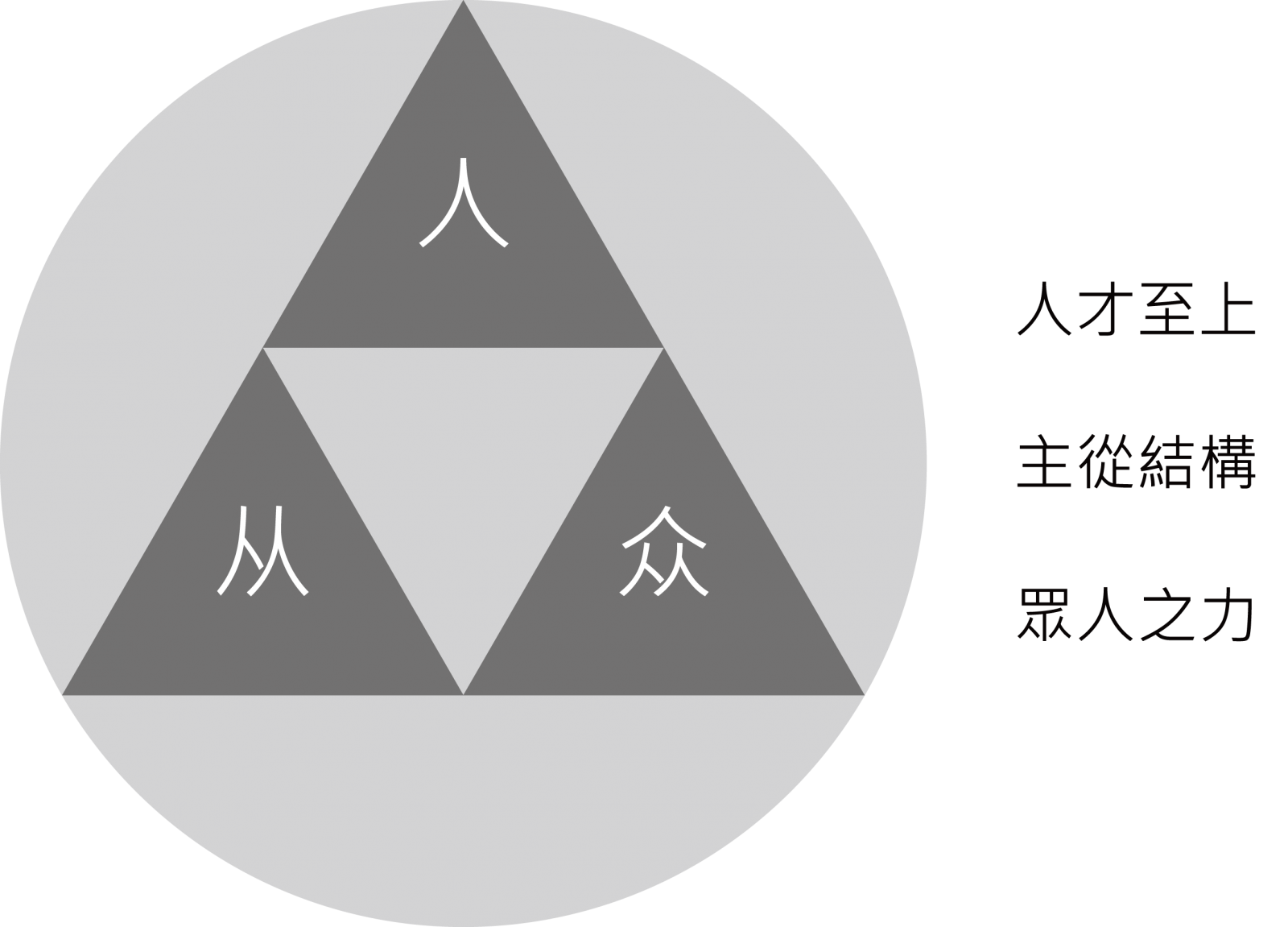
Figure 3. The Composition of “Individual, Pair, Group”
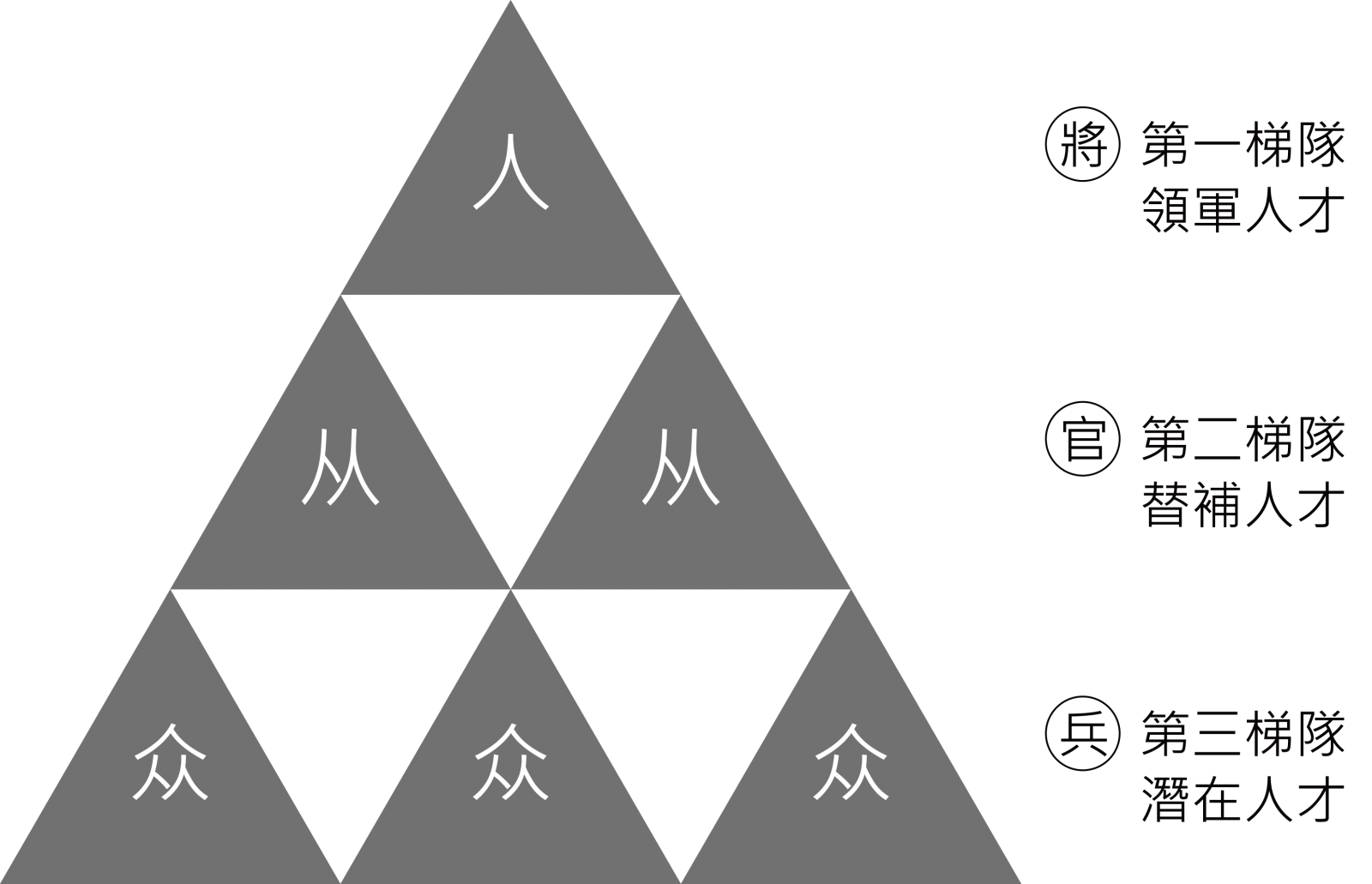
Figure 4. The Structural Relationships within “Individual, Pair, Group”
In terms of the strategy model of the cultivation of design talent for Taiwan’s cultural and creative industry, there are four pillars that are based on solid infrastructure. The objectives of these four pillars correspond to the four sub-projects under Art and Design Talent Cultivation of the Ministry of Education, and they construct the human-capital-oriented top design strategy for Taiwan’s cultural and creative industry (as indicated in Figure 5 and Figure 6 on the next page). The description is as follows:
1. Art and Design Education Resources Center Project: objective-oriented; an education model.
2. Art and Design Overseas Talent Training Project: global participation; a cooperative platform.
3. International Design Competition: international competitiveness; an elite project.
4. Taiwan International Student Design Competition: emphasis on quality; a performance indicator.
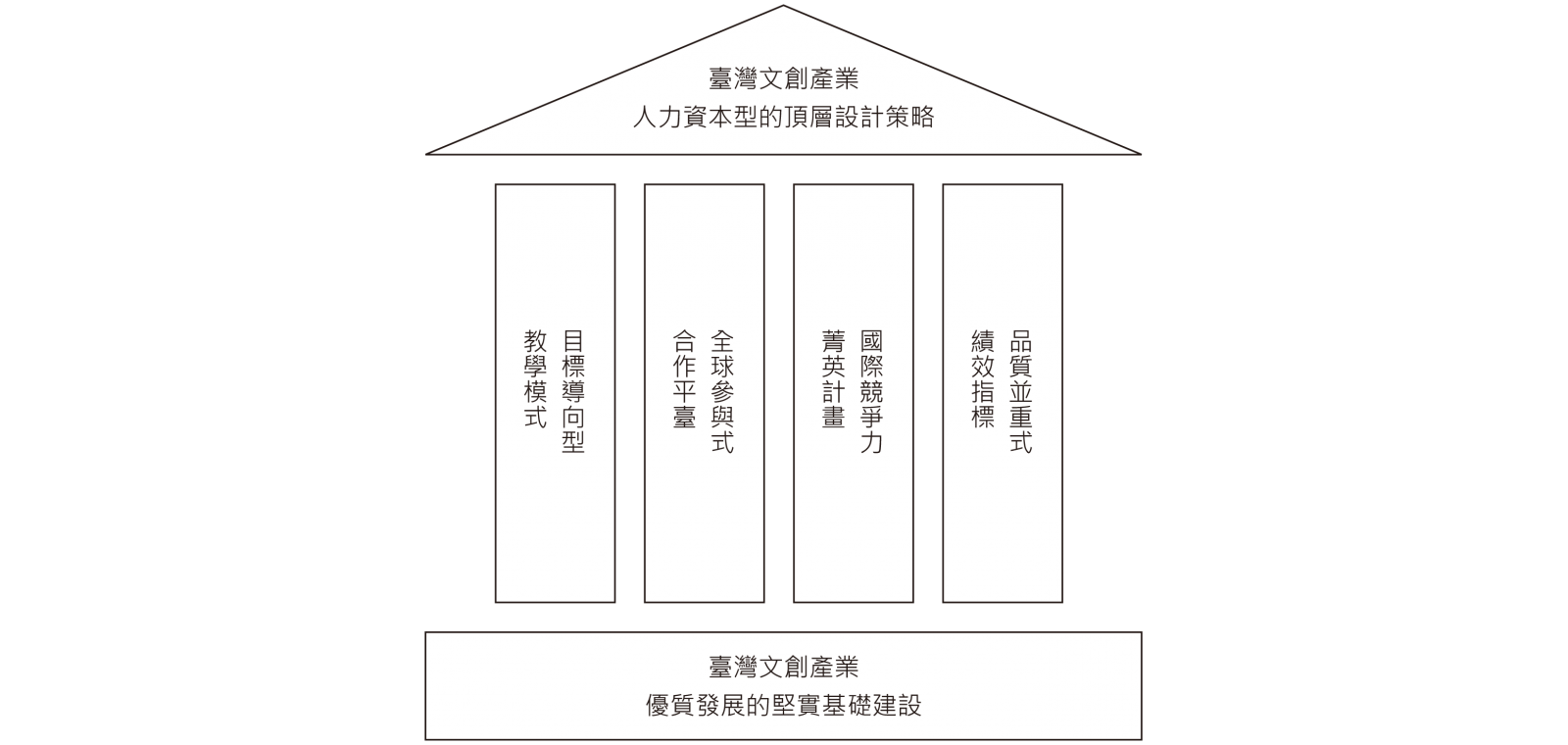
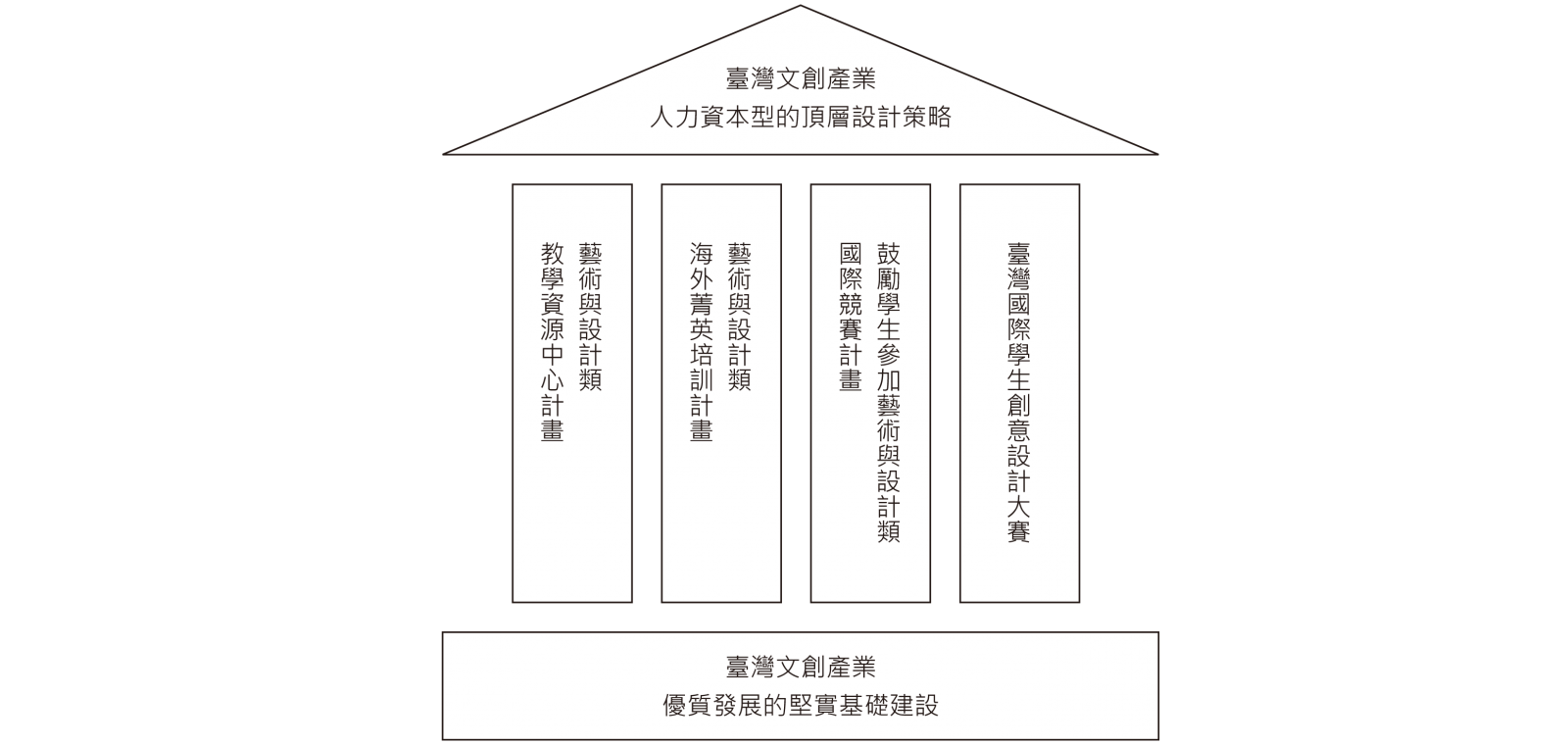
IV. The Strategic Mechanisms of International Design Competition
The Ministry of Education’s “International Design Competition” (“Award Incentive Program for Encouraging University/College Students to Participate in International Art and Design Contests”) started in 2005, and Professor Apex Lin, Pang-Soong was invited to be the project manager for drafting plans, setting up goals, determining targets, formulating strategies and expert deliberation and trials. Domestic experts and scholars were invited to jointly establish the standards for participating in international art and design competitions, which were categorized into “General Design,” “Product Design,” “Graphic Design,” “Digital Animation,” and “Industrial Design.” These experts and scholars followed the rules and regulations of different international contests and assessed students’ capabilities before selecting 40 international art and design competitions as targets of participation. Afterwards, award levels and corresponding reward sums were discussed (Apex Lin, Pang-Soong, 2006).
Different from the year of 2005, when “defining standards” was the project goal, the key point of the project in 2006 was “introducing information” (Apex Lin, Pang-Soong, 2006). There were four phases of implementation, which were planning, promotion, development and maturity, respectively (Table 1). As the core factor of design strategies and methods, high reward sums were used to motivate students to take part in international design competitions and to create a virtuous competition environment and mutually beneficial synergy. Nowadays, we have entered the maturity phase. “Design takes root; creativity plows deep.” The aims are to unleash the power of the sustainable development of Taiwan’s design education, to collect and sort out the information and materials on different international design competitions, to set up a relevant website and talent database, to provide relevant educational materials, and to organize discussions and rewards on international art and design contests. The award-winning students’ works could be exhibited abroad, which would help build a virtuous ecosystem for Taiwan’s design and creative talent cultivation.
| 時間 | 階段 | 策略 |
| 2005年 | 規劃期 | 研擬推廣實施策略及輔導措施 定義國際設計目標及獎勵機制 |
| 2005年至2010年 | 推廣期 | 投入高額獎勵機制,提高國際參賽獲獎 北中南區域的巡迴推廣,落實學校參與 |
| 2011年至2015年 | 發展期 | 國際競賽品質並重目標與實施策略 創意作品商品化與設計人才產業化 |
| 2015年起 | 成熟期 | 專業化、深耕化、國際化、產學化 |
International Design Competition is a strategic planning which aimsto internationalize Taiwan’s design education and enhance its competitiveness;it is a strategy to “push” and “promote.” Its naming in Chinese relates to Strategies of the Warring Statesauthored by Liu Xiang from the Western Han dynasty. During the Warring Statesperiod in ancient China, state advisors formulated political statements anddiplomatic strategies to assist the development of their own state. TaiwanInternational Student Design Competition, on the other hand, is a strategy to “pull”and “introduce” (ApexLin, Pang-Soong, 2009).
That is to say, when the forces of “push” and “pull”are strategically combined, it creates a “migrant bird effect,” whichconstitutes the concept of flowing assets of talent. The aim is to cultivate agood environment for Taiwan to enter the world and for the world to see Taiwan.From “Art and Design Elite Overseas Training” to “Award Incentive Program forEncouraging University/College Students to Participate in International Art andDesign Contests,” young talent can be pushed onto the international stage bywinning international design competitions, which creates an outbound effect. Asfor Taiwan International Student Design Competition, when designers, expertsand scholars from home and abroad are invited as selection jurors, wheninternational design conferences are organized, and when winning entries areexhibited overseas, bridges between countries can be built, and an inboundexchange platform can be created (Figure 7). The description is as follows:
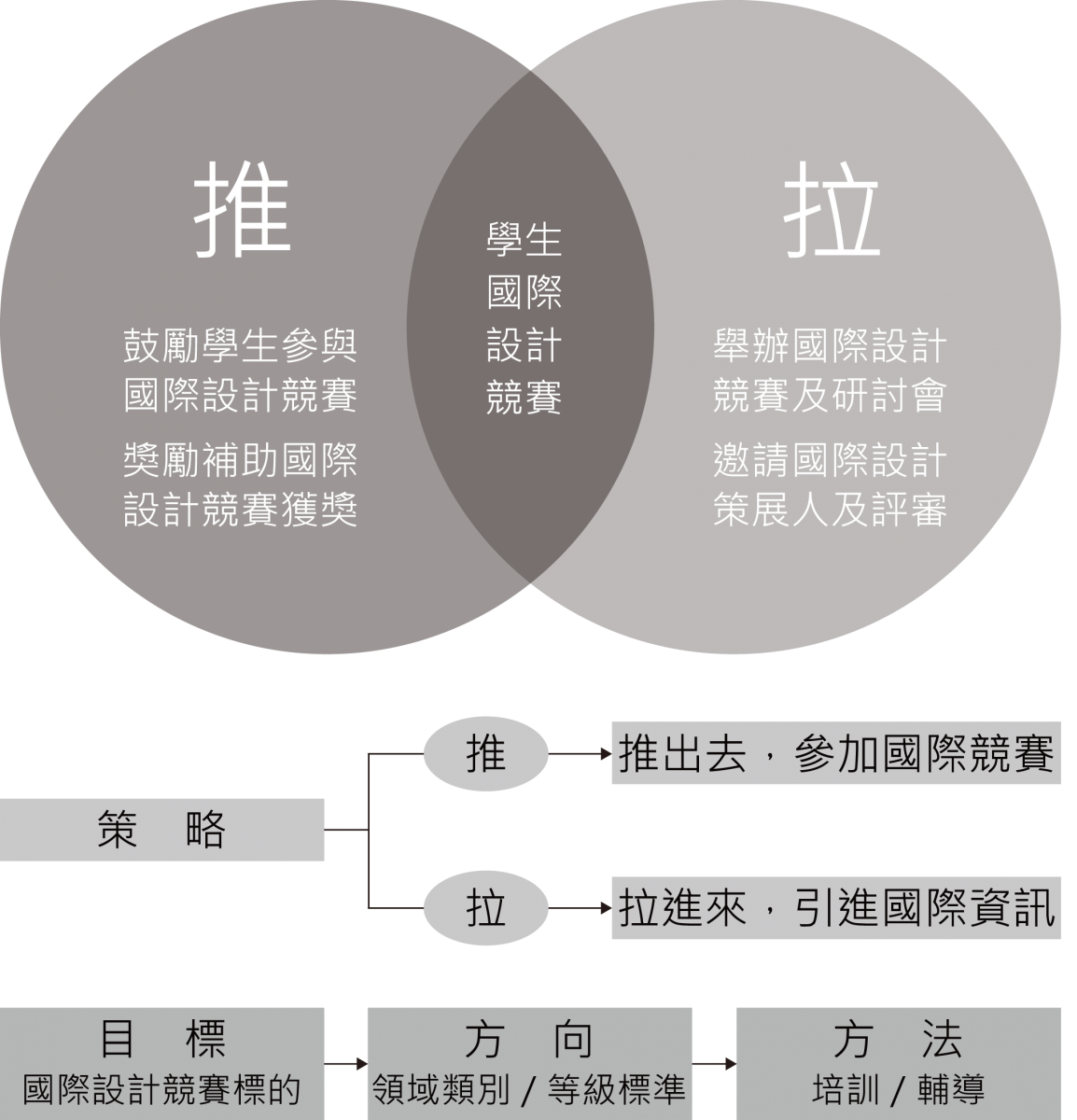
V. Conclusion
1. Design Talent Cultivation for Taiwan’s Cultural and Creative Industry
Creative talent is the foundation of a country’s development of the creative industry. Cultivating talent with originality and developing industry-oriented strategic models are a country’s cornerstones with regard to enhancing its creative economy. The effective management of human resources and the sustainable cultivation of talent are the key factors of a country’s design education policy (Apex Lin, Pang-Soong, 2012). I have adopted the theory of human capital to explore the meaning behind “Individual, Pair, Group.” “Individual” represents the essence of human nature, so high reward sums are set up as incentives. “Pair” means mutual comparison, establishing competition mechanisms and strategies. “Group” refers to building a structure of people as a group and constructing such a system in order to shape human-capital-oriented pillars of planning.
In 2011, which was the Year of Design in Taiwan, the three international design associations of ICSID (International Council of Societies of Industrial Design), ICOGRADA (International Council of Graphic Design Associations) and IFI (International Federation of Interior Architects/Designers) formed IDA (International Design Association). Taiwan’s design energy was praised by the international design community (Apex Lin, Pang-Soong, 2011). Regarding the future, the goal will be to push forward the sub-project of International Design Competition, which is “Design Takes Root·Plows Deep: Design Youth Promotion Project.” It will be able to integrate the Ministry of Education’s current resources and cooperate with Taiwan design associations in a cross-disciplinary fashion (Apex Lin, Pang-Soong, 2017). In the era where advanced countries are all advocating interdisciplinary integration for design leadership, Taiwan is also gradually emerging and moving towards strategic cooperation, development and design partnerships, which can increase design value and energy.
2. Establishing an Exchange Platform of International Design Competitions
The cultivation of design and creative talent worldwide has become internationalized, interdisciplinary and diverse. Therefore, it is important to establish a solid and firm platform and build bridges for international design education exchanges as a way to influence the creative performance of the youth worldwide. Since 2006, International Design Competition has been continuously encouraging students to take part in art and design international contests for 13 years. Nowadays, against the backdrop of information technology impacting the entire world, Taiwan continues to take a firm lead in the Chinese-speaking world with regard to design education, and it keeps connecting the network of international design education exchanges, which is truly a precious asset.
In 2017, during the Global Design Leadership Forum, Dr. Brandon Gien, founder and CEO of Good Design Australia, mentioned the 5th industrial revolution and the advent of big data, artificial intelligence and robotics. Faced with such challenges in the digital era, it is now necessary to be able to observe the social landscape of the future and create design value accordingly. The advantages of human beings include aesthetics, emotions and creative capabilities. Therefore, in terms of the direction of current design education, it is essential to cultivate “local-global” thinking among the youth, allowing them to be open-minded, to break through and innovate, and to embrace the challenges of globalization.
3. Guiding the Youth to Connect with the Industry
In his article titled “Why Design Education Must Change,” Donald Norman (2010) mentioned that nowadays, designers lack the training that fulfills the needs of the times and that we need interdisciplinary design talent and innovative design education models to pay attention to social and behavioral science as well as to modern technology and business opportunities. The design community needs to lead such changes. In other words, the changes need to take place in many different aspects, from design education and training to practical talent cultivation, and from initial conceptualization of a work to the mass production and commercialization of commodities. Connecting the industry and the academia is the responsibility of both design educators and people from the industry. Given the global hype of cultural and creative thinking, it is now imperative to better fulfill corporate talent demand and enhance the value of design education and talent. As such talent is equipped with relevant capabilities, they will be able to influence the competitiveness of industries of the nation and that of economic development. Some research findings have been displayed and reviewed in “The Planning and Design of Relevant Courses” (Lin, Mei-ting, 2017) That is to say, it is imperative for design education to take root, for the course design to become more creativity-oriented, for evaluation criteria to take into account creative capabilities, and constructing a strategic model and making a bottom-up, grass-root difference for talent cultivation are truly essential
In 2017, during the same Global Design Leadership Forum, Mr. Kazuo Tanaka, CEO of GK Design Group, advocated the spirit of “social design” in his works and the efforts to solve problems, fulfill others’ needs and transform the urban environment. The National Development Council of Taiwan’s Executive Yuan advocates “Design to Flip and Revitalize Rural Areas,” with the core ideas of “creativity, innovation, entrepreneurship and revitalization” and the aim to mitigate inequalities between rural and urban human resources and development. It is hoped that “works, products and commodities” will create a multiplying effect for “the power of design, production and marketing” (National development Council, 2017). “The endpoint needs to be the starting point.” Commodities are meant to satisfy consumers’ needs, so creative ideation, mass production potentials and arousing the willingness of customers to repurchase a given commodity are all core objectives in the planning of design education and professional cultivation.
VI. Reference
Donald Norman(2010). Why Design Education Must Change. 2017/12/14取自http://www.core77.com/posts/17993/why-design-education-must-change-17993
Donald Norman(2010). Why Design Education Must Change. 2017/12/14 Extracted from http://www.core77.com/posts/17993/why-design-education-must-change-17993
Theodore W. Schultz(1961). Investment in Human Capital. The American Economic Review, Vol. 51, No. 1, pp. 1-17.
Graphic Design Association of the Republic of China (2006). Design Education Summit Special Report. Taipei City: Design Impression.
Lin, Yan-dan (2011). Cultural and Creative Industry: Theory and Practice. Taipei City: NTNU Bookstore.
Lin, Mei-ting (2017). An Exploration of Taiwan Design Education from a Perspective of Cultural Creation. A doctoral dissertation from the Graduate School of Creative Industry Design, National Taiwan University of Arts. Taipei City.
Apex Lin, Pang-Soong (2006). 2006 International Design Competition—the Ministry of Education’s “Award Incentive Program for Encouraging University/College Students to Participate in International Art and Design Contests.” Taipei City: Ministry of Education.
Apex Lin, Pang-Soong (2008a). International Design Competition 2008: Award Incentive Program for Encouraging University/College Students to Participate in International Art and Design Contests. Taipei City: Ministry of Education.
Apex Lin, Pang-Soong (2008b). 2008 Taiwan International Design Competition: Winning Entries of the Student Group. Taipei City: Ministry of Education.
Apex Lin, Pang-Soong (2009). 2009 Taiwan International Design Competition: Winning Entries of the Student Group. Taipei City: Ministry of Education.
Apex Lin, Pang-Soong (2011). 2011 Taiwan International Student Design Competition Results. Taipei City: Ministry of Education.
Apex Lin, Pang-Soong (2012). International Design Competition 2012: Award Incentive Program for Encouraging University/College Students to Participate in International Art and Design Contests. Taipei City: Ministry of Education.
Apex Lin, Pang-Soong (2014). International Design Competition 2014: Award Incentive Program for Encouraging University/College Students to Participate in International Art and Design Contests. Taipei City: Ministry of Education.
Apex Lin, Pang-Soong (2017). International Design Competition 2017: Award Incentive Program for Encouraging University/College Students to Participate in International Art and Design Contests. Taipei City: Ministry of Education.
Ministry of Education (2007). Implementation Guidelines of the Ministry of Education’s Financial Support for Art and Design Elite to Study Abroad. Taipei City.
Ministry of Education (2012). Ministry of Education’s Objectives and Emphasis of Its Policy Implementation in 2010. Taipei City.
Ministry of Education (2017). Higher Education Deep-Plowing Project (Verified Version). Taipei City.
Department of Higher Education of the Ministry of Education (2016). Ministry of Education’s Financial Support for Universities and Colleges to Organize Art and Design Talent Cultivation Programs: Application Regulations. Taipei City.
National Development Council (2017). “Design to Flip and Revitalize Rural Areas” Planning and Implementation Guidelines. Taipei City.
Zhang, Guang-min (2009). Development Planning for the Cultural and Creative Industry. Extracted on 2017/10/26 from http://nrch.culture.tw/twpedia.aspx?id=2483
Zhang, Yu-teng (2013). Seeing Taiwan—Apex Lin, Pang-Soong’s Art and Design. Taipei City: National Museum of History.
United Nations’ Conference on Trade and Development as the original author, and Lin, Yan-dan as the chief editor (2011). 2010 Report on Creative Economy. Taipei City: NTNU Bookstore.
Acknowledgement
Thanks are due to Professor Apex Lin, Pang-Soong, who has provided the materials of the course “Seminar on Design Education,” which he taught in the Graduate School of Design at National Taiwan Normal University